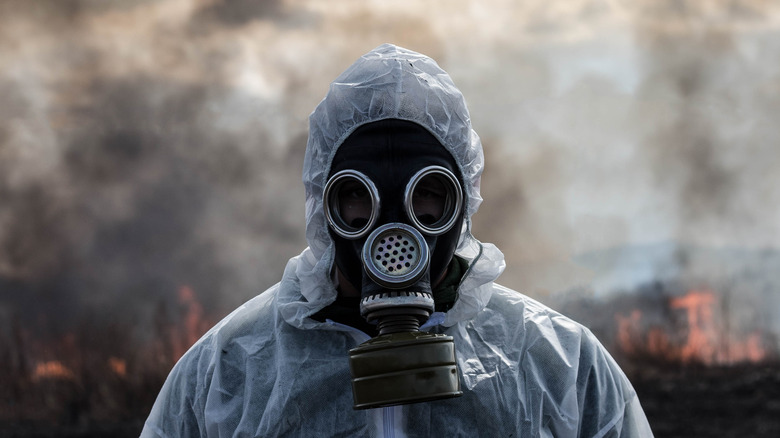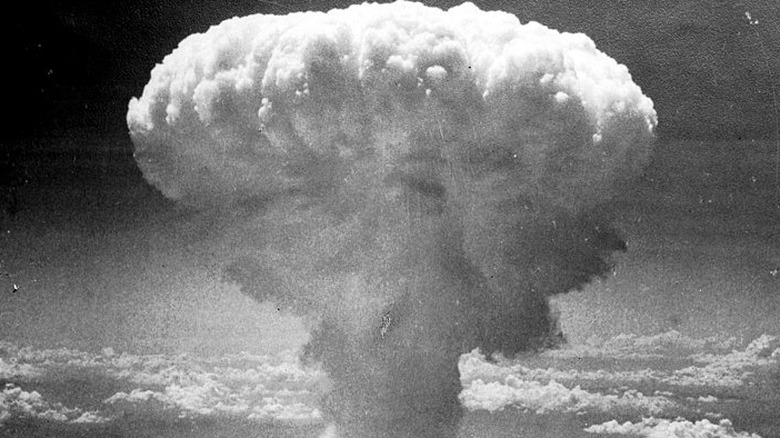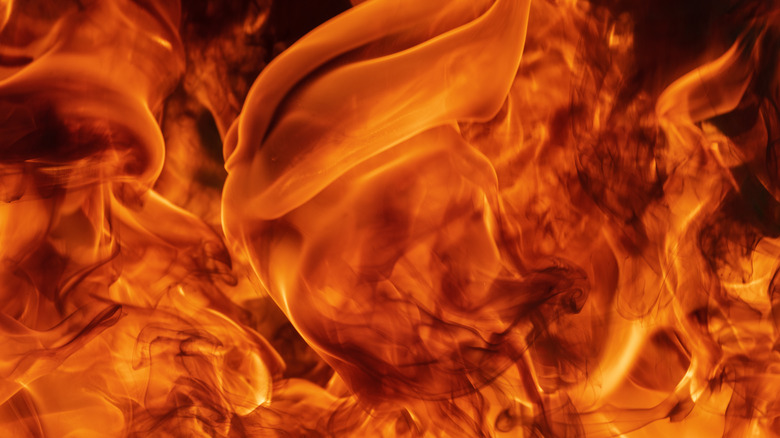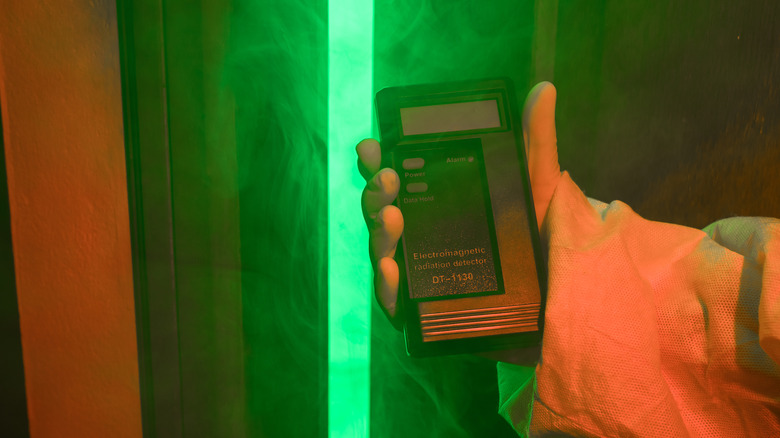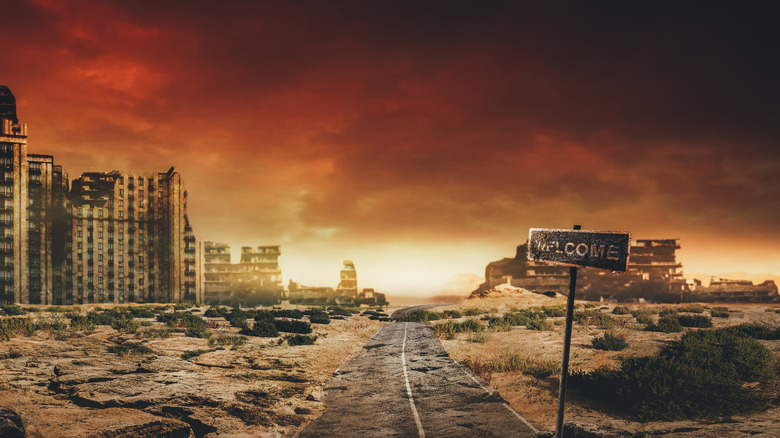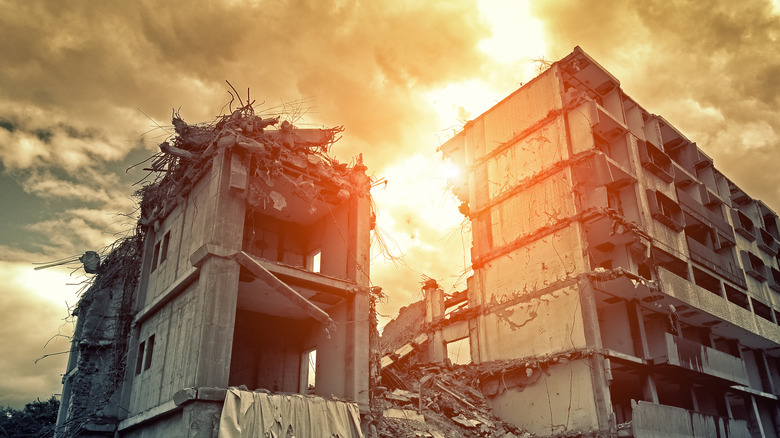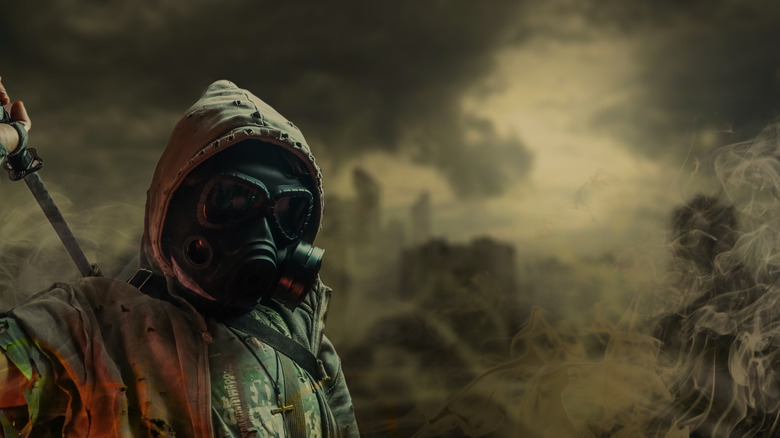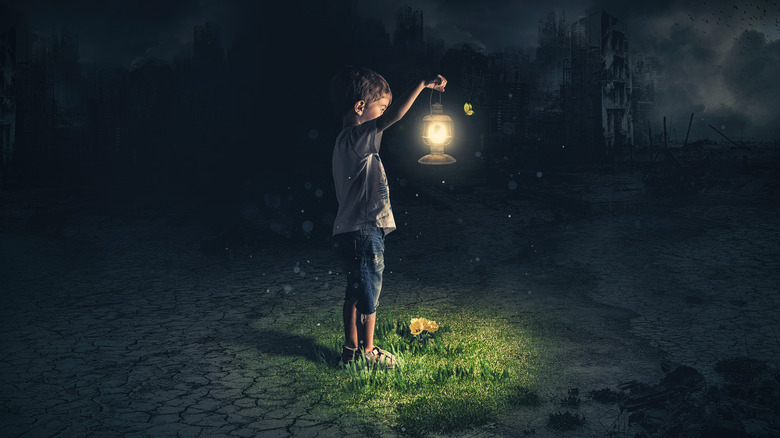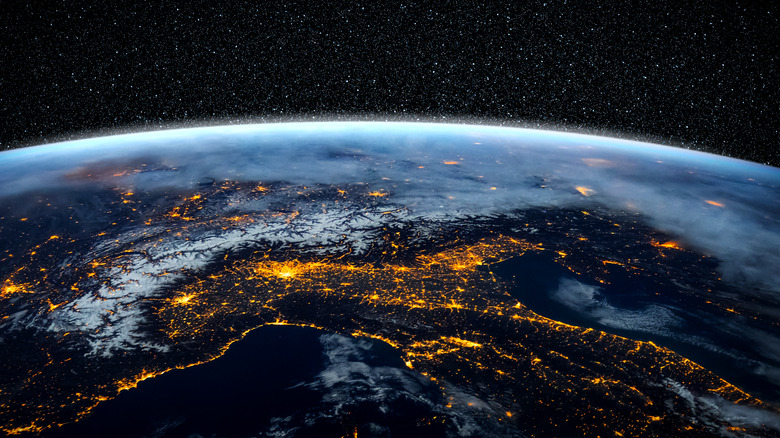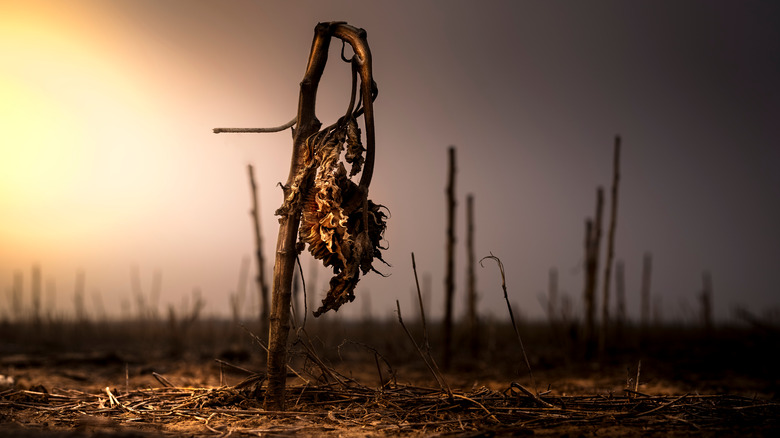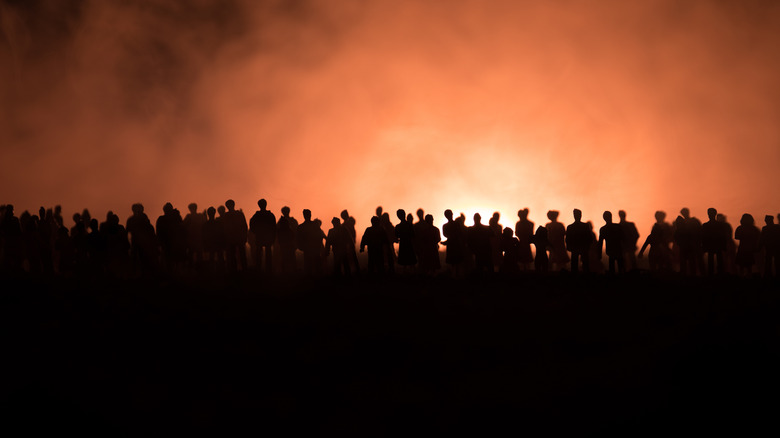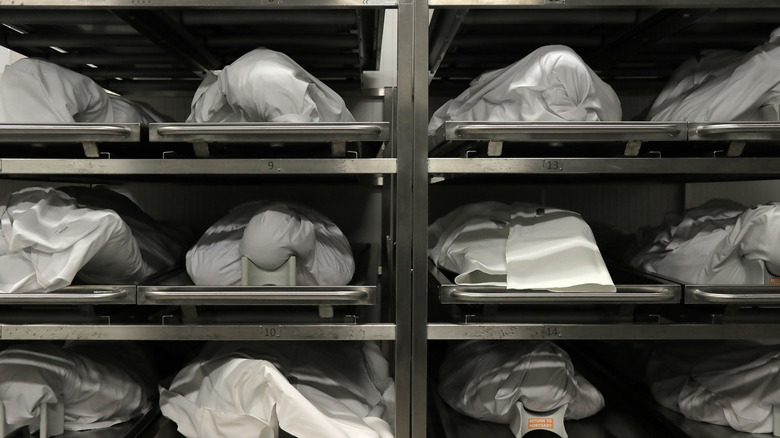What A Nuclear Missile Strike Really Does
Despite its many practical uses in the modern world, nuclear power carries a bit of a negative reputation. Disasters involving nuclear power — perhaps most notably, the infamous Chernobyl incident of 1986 — have left a near-indelible stain on the minds of many people, even though today's nuclear-powered technologies are said to be much safer (per ZME Science). Some folks may not even be aware of the numerous applications of nuclear science in everyday life, from medicine to food production, and from safety to transportation (via the World Nuclear Association).
That said, nuclear warfare is an entirely different matter, and for a very good reason. According to Science Focus, there are at least 19,000 nuclear warheads across the world, based on the Federation of American Scientists' count. The accuracy of this estimate can't exactly be verified, as nuclear weapons development tends to be top secret in the countries that possess the capacity to advance it. However, approximately 95% of these nuclear weapons are said to be from the United States and Russia, with about 200 from the United Kingdom. And if any of these weapons were to be unleashed upon an unsuspecting territory or populace, the outcome would certainly be terrifying.
Nuclear strikes are the stuff of post-apocalyptic futures and dystopian realities in fiction. However, the world has been unfortunate enough to witness the kind of destruction they can bring — and it's not a pleasant sight. Here's what a nuclear missile strike really does.
The mushroom cloud
For many people, the most instantly recognizable aspect of a nuclear strike is the gigantic mushroom-shaped cloud that rises from the site of the attack. As Britannica explains, the "nuclear fireball" that emerges as soon as the missile hits its target contains immensely hot gases that rapidly expand outward. This expansion, brought about by the sheer pressure in the fireball, creates a shock wave and strong winds with horrific destructive potential. Depending on the size and power of the bomb, its crushing pressure can destroy houses and buildings, as well as send various types of large debris (such as glass, metal, and wood) flying. And of course, the odds of anyone surviving within the vicinity of the blast are quite low.
According to the International Committee of the Red Cross (ICRC), the bombs that hit the Japanese cities of Nagasaki and Hiroshima during World War II were quite small by today's standards, and they were detonated a little over 3,000 feet above the cities. With today's nuclear weapons estimated to be up to 30 times bigger, the destructive potential would also increase accordingly, if not more.
Of course, the damage doesn't stop after impact — it only marks the beginning of the catastrophe. Powerful waves of thermal and nuclear radiation follow, leading to more destruction and death.
Thermal radiation would follow
In a nuclear strike, a little over a third of the airburst's energy yield comes out in the form of intense heat (per Britannica). This powerful wave of thermal radiation can not only inflict serious damage on the eyes and skin of people within its area of effect, but also set materials on fire, even those located at a significant distance from the site.
According to the ICRC, the temperature of the land beneath a nuclear site can peak at 7,000 degrees Celsius. At that point, most living things — plants, animals, humans — would simply cease to exist. Anything that wasn't immediately vaporized would be toasted. It would be tough to call any nearby survivors "lucky," either, as they would likely sustain severe skin and retinal burns, scarring, and even temporary blindness.
The shock wave that follows a nuclear strike can potentially make things worse by spreading already raging fires even further (via Britannica). Given enough time to spread and burn, these separate fires can create a gigantic firestorm that draws in fresh air. This firestorm creates a rising pillar of extremely hot gases that can burn pretty much anything on site. However, the geographical location of the nuclear strike can impact how devastating the resulting firestorm will be, as observed in the cases of Nagasaki and Hiroshima. As Nagasaki's terrain is full of hills, the damage was only about a quarter of what was seen across Hiroshima's level landscape.
Initial radiation
Following the fireball generated after a nuclear weapon detonates, nuclear radiation is emitted in two phases: prompt or initial radiation, and residual radiation (via Britannica).
Within 60 seconds of the blast, gamma rays and neutrons are generated, as well as alpha and beta particles. As NASA explains, gamma rays — which are the product of extremely hot and powerful phenomena such as black holes and supernovas — contain the most energy among all the waves across the electromagnetic spectrum. Unsurprisingly, these high-energy waves can create serious health complications for living things that are unfortunate enough to be within the vicinity. Thus, gamma radiation tends to be responsible for a "considerable" number of deaths following a nuclear strike. This is despite the fact that gamma rays and neutrons make up less than 5% of the overall energy that an exploding nuclear weapon produces.
The ICRC lists a number of health afflictions that a person hit by gamma rays would experience almost instantly — and "comic book superpowers" most certainly isn't one of them. For starters, the person would likely suffer from diarrhea, nausea, and vomiting due to gastrointestinal tract damage. The victim's body would also have trouble processing nutrients, and the individual may even die from dehydration. They would also be incapable of creating new blood cells, leaving them more prone to infections and uncontrolled bleeding. And if the person were bombarded with an extremely high dose, their central nervous system would stop functioning.
Residual radiation and fallout
The emission of radiation that takes place a minute after the explosion of a nuclear weapon is called residual radiation, and it involves over 300 different isotopes of assorted elements (per Britannica). The source and spread of said radiation varies depending on where the weapon was detonated. In the event of an airburst, the residual radiation will come from parts of the detonated weapon itself. Nuclear explosions closer to the surface will draw water, soil, and detritus from the area into the resulting mushroom cloud.
As these irradiated particles begin their descent and spread across the land, they can cause both local and worldwide fallout, with the former taking place within a day and the latter happening some time later. Local fallout happens as the particles fall back to the ground within 24 hours of contamination, inadvertently turning the parts where they settle into dangerous, contaminated areas. Other particles carried by the wind can spread to different areas of the planet, contaminating places that weren't even part of the nuclear weapon's blast radius. That said, experts say that the hazard presented by residual radiation decreases exponentially as more time passes after the explosion.
Per the ICRC, surviving the initial exposure to nuclear radiation doesn't offer victims any guarantee. Radiation sickness can hit them weeks or even months later, and their risk of developing thyroid cancer, leukemia, and other kinds of cancer would also increase.
An electromagnetic pulse
A nuclear strike also creates an electromagnetic pulse (EMP), which is the result of the gamma rays from the initial radiation colliding with air molecules (via Britannica). These collisions produce high-energy electrons. In the process, negatively charged electrons (which are lighter) are scattered away from the site of the nuclear strike, while the positively charged air molecules (which are heavier) remain. The distribution of electrons generates an electric field whose shape is affected by air density variations based on altitude, how close the nuclear explosion was to Earth when it happened, and other factors. When an EMP hits unprotected electronic equipment, it can take communication systems, computers, and other vital gear out of commission.
One of the most famous examples of EMP damage caused by a nuclear weapon took place on July 9, 1962, during a military weapons test codenamed Starfish Prime (per Smithsonian Magazine). A 1.45-megaton hydrogen bomb exploded about 250 miles above Johnston Island in the north Pacific Ocean. As soon as the detonation of the bomb — which was around a hundred times stronger than the one that struck Hiroshima in 1945 — an EMP caused a massive electrical disruption in Hawaii. The explosion also created a spectacular three-minute display of colorful lights that was visible even to people 2,000 miles away from the site.
Ever since scientists took note of EMPs and their devastating effects on electronics in the 1950s, they have been developing ways of "hardening" or bolstering their defenses against such fields.
A potential nuclear autumn
According to the Arms Control Association, there are five nuclear-weapon states (NWS) recognized in the world: the United States, United Kingdom, France, China, and Russia. There are the five territories confirmed by the 1968 nuclear Nonproliferation Treaty (NPT) to be in possession of nuclear weapons. They're not the only ones, though, as India, Israel, North Korea, and Pakistan all have nuclear weapons, too — and it would only take a "small" nuclear fight between two nuclear-equipped countries to kick off what experts call a nuclear autumn (via Vox).
In a nuclear autumn, the resulting black smoke from the detonation of nuclear weapons could bring about accelerated climate change, affecting global temperatures and food production severely. Based on 2016 estimates, a nuclear autumn could bring worldwide temperatures lower than the so-called Little Ice Age that took place from the 14th to 19th centuries. This, in turn, could easily bring down the production of corn, wheat, and other important agricultural products by as much as 40% in the span of just five years. This drastic drop in food production would put billions of people across the world — particularly in Europe, Latin America, North America, and Southeast Asia — at risk of starvation.
It could also give birth to another nuclear war, as nuclear superpowers struggle to take control of an already dwindling global food supply to feed their citizens. Worst of all, it would only take five conventional nuclear bombs to trigger this nightmare scenario (per ZME Science).
The possibility of a nuclear winter
If the prospect of the world's climate changing because of a few nuclear bombs sounds scary, then an all-out nuclear war between major nuclear superpowers could very well lead to the extermination of the human race.
As Vox explains, a so-called nuclear winter could take place if two countries with advanced nuclear weapons (such as Russia and the United States) decided to go to war, laying waste to highly populated areas by bringing down 2,000 nuclear strikes upon each other's territories. Aside from the death and destruction from the detonations themselves, the debris and smoke that such a war would generate could be enough to "block out the sun for years" (via ZME Science). Like a nuclear autumn, this would affect crop growth rates and food production for many years. However, the impact would be much, much worse.
Countless people across the world — many in countries that had no involvement in the nuclear war to begin with — would starve to death, and the world would turn dark and cold. Moreover, global precipitation rates would drop by nearly half, which pretty much guarantees that very little life would survive anywhere. And that hasn't even factored in how the planet would be bombarded with ultraviolet radiation due to the depletion of the ozone layer. It would reach the point where even the simple act of walking outdoors could give a person sunburn.
Women and children would suffer disproportionately
As the ICRC explains, there wouldn't be enough immediate medical aid available for all the people who would need it in the event of a nuclear strike. However, what some may not realize is that in these scenarios, women and children tend to suffer more severe physical, mental, and emotional effects — especially children who weren't even born yet when the nuclear weapons struck their hometowns.
For starters, the different gender roles and responsibilities that many societies assign to men and women tend to put the latter group at greater risk (per the United Nations Institute for Disarmament Research). Research has also shown that ionizing radiation tends to affect women to a more severe degree than men. Following the accident at the Chernobyl nuclear power plant, women in nearby regions reportedly suffered more stress, and were more likely to take precautionary measures. Even abortion rates rose sharply, particularly in Ukraine — and in many cases, abortions were recommended for women even though they didn't completely understand why they would be necessary.
The Norwegian Institute of International Affairs reports that from 1949 to 1991, the Soviet Union conducted over 450 weapon tests in Kazakhstan's Semipalatinsk nuclear site. Based on available data, these tests affected the health of over a million people. There was a drastic increase in cases of nervous system and factual malformations in children born before 1985. Additionally, twice as many children died of leukemia compared to 1945 to 1948 statistics.
Large-scale displacement
A nuclear disaster would likely also mean the displacement of families living in affected areas (per the United Nations Institute for Disarmament Research). Often, people caught in the middle of nuclear conflicts are left with no other option than to run for their lives.
Displacement brought about by nuclear strikes can greatly reduce the quality of life of those who are affected. Aside from disrupting their daily routines, these individuals and families also take tremendous blows to their finances. Children are forced to stop going to school, while their parents scramble to find a place to live and jobs to sustain their families. Furthermore, moving to a new and unfamiliar location means increasing their chances of getting sick or being subjected to violence or racial discrimination.
And of course, there's the emotional trauma that comes with this disruption. On top of everything else, women who survived the attacks on Hiroshima and Nagasaki reported being humiliated and maltreated during the examination processes that they needed to undergo to move to a safer location (via the United Nations Institute for Disarmament Research).
Environmental damage and global famine
According to Vox, even one nuclear strike could be enough to kick off drastic climate cooling, resulting in global famine. As soot, smoke, debris, and other particles are sent to the stratosphere by the explosion, they could form a barrier preventing the sun's energy from reaching the surface. And since rainfall would also be cut by half, there would be nothing to wash out said barrier from the stratosphere, meaning it would remain there for a very long time. Without the sun's life-sustaining energies, countless terrestrial and aquatic organisms would die.
In a paper published by the International Physicians for the Prevention of Nuclear War, experts outlined some of the most devastating effects of nuclear disaster that would bring about widespread famine and permanently damage the environment. These include a progressive decline of corn and soybean production in the United States over the course of a decade, as well as a 21% average decline in rice production in China for four years.
With the drastically reduced global food supply would come steep increases in food prices — and in a world where over 900 million people are already suffering from long-term malnourishment, that number would swell beyond a billion in less than 10 years.
Massive social and political disruption
The reality is that no country is truly, fully prepared to handle the inevitable medical crisis that would follow a nuclear disaster. Per the ICRC, life-saving facilities and equipment would most likely cease to work in areas affected by nuclear strikes, and medical responders would also be included in those killed or injured.
Moreover, countless industries centered in urban areas would undoubtedly suffer, which would likely cripple the economy. From educational institutions to research facilities to product manufacturing and distribution chains, society would experience a massive disruption. Meanwhile, on the political side of things, the destruction and loss of life brought about by a nuclear attack could mean the loss of government offices, official records and documents, and even important political players and employees (via Article 36).
During a presentation at a 2013 conference in Oslo, Norway, the UN's Neil Buhne summed up these challenges, especially in developing countries: "Unfortunately, for many developing countries, government capacities for disaster management are still extremely limited. So communities from these countries are going to be much more vulnerable to the pronounced wider and deeper risks posed by nuclear contamination, including from a nuclear detonation."
Many would die
While the impact of nuclear strikes on society, politics, and the environment are certainly terrifying to consider, it is perhaps the tremendous loss of life that truly leaves a mark on humanity's collective consciousness. Whether as a result of the heat and nuclear radiation, the collapsing buildings and flying debris, the sheer force of the initial explosion, or the long-term health risks associated with nuclear exposure, the number of human casualties is simply horrifying to imagine.
By today's standards, the bombs that laid waste to Hiroshima and Nagasaki are small. And yet, their respective death tolls were significant. By 1950, the casualties caused by the Hiroshima bombing had reached 200,000, while the Nagasaki fatalities reached 140,000 (per the ICRC). While many survived the blasts, a great number of these people eventually developed serious illnesses such as breast, esophageal, colon, and lung cancer due to their exposure to radiation.
As Vox puts it, it only takes a single nuclear detonation "to conceivably kill hundreds of thousands of people within minutes and perhaps millions more in the following days, weeks, and years."
